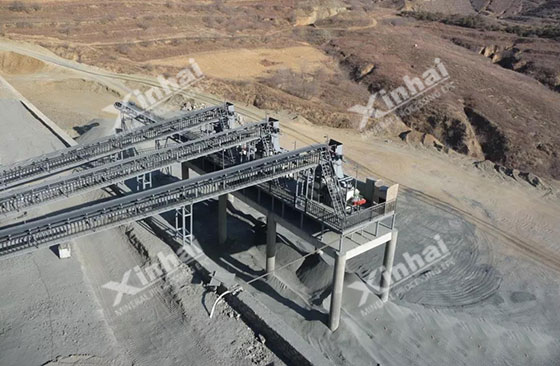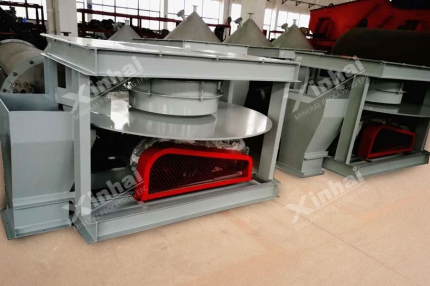At present, more than 300 kinds of iron ores have been found in nature. According to the classification of their chemical composition, the iron ore can be divided into magnetite, hematite, limonite and siderite. According to the specific magnetization coefficient, the iron ores can be divided into strong magnetic minerals and weak magnetic minerals, which provides a basis for the selection of iron extraction process. Different properties of iron ore make the iron extraction processes different.
Use the table of contents below to navigate through the guide:
01Strong magnetic iron ore
1. Single magnetic iron ore
The iron ore in the single magnetic iron ore is mostly magnetite. Because the magnetite ore is featured with simple composition, strong magnetism and easy to grind and separate, so the weak magnetic separation process is often used to deal with single magnetic iron ore.
When the grinding size is larger than 0.2mm, most iron magnetic separation plants adopt one stage grinding- magnetic separation;
When the grinding size is less than 0.2mm, two-stage grinding- magnetic separation process is adopted;
If the qualified tailings are separated at the rough grinding stage, the iron magnetic separation plant should adopt stage grinding- magnetic separation process;
For those arid areas, the iron magnetic separation plant can adopt dry grinding - dry magnetic separation process.
2. Polymetallic magnetic iron ore
Usually, the gangue mineral of polymetallic magnetic iron ore often contains cobalt silicate, carbonate minerals, pyrite, chalcopyrite and apatite. It is recommended to adopt weak magnetic separation- flotation process, namely recycling the iron by the weak magnetic separation process, then recycling the sulfide or apatite through the flotation process, which is conducive to obtain higher ore dressing indexes.
Generally, the weak magnetic separation – flotation joint process is also divided into two types: weak magnetic separation – flotation process and flotation - weak magnetic separation process. The difference between the two processes is that the coenobium direction between the magnetite and the sulfide is different.
In the weak magnetic separation – flotation process, the coenobium mainly enters into iron concentrate.
In the flotation - weak magnetic separation process, flotation - weak magnetic separation process mainly enters into sulfide concentrate.
The result shows, under the same grinding size, adopting flotation first and then magnetic separation process can obtain low-sulfide contained iron concentrate and high-recovery sulfide concentrate.

02Weak magnetic iron ore
1. Single weak magnetic iron ore
Single weak magnetic iron ores mainly include hematite, siderite, limonite and hematite (vitrinite) - siderite, etc. Due to its various kinds and the wide range of disseminated grain size, the mineral processing method is also relatively complex, such as gravity separation, flotation, strong magnetic separation process or combined process.
Flotation process is mainly used for separation of weak magnetic iron ore with fine particles, including positive flotation and reverse flotation process. Among them, the positive flotation process is suitable for the quartz hematite without easily floating gangue, while the reverse flotation process is suitable for the iron ore with easy-to-float gangue ore.
Gravity separation process and the strong magnetic separation process are mainly used to separate coarse (2mm-20mm) and medium weak magnetic iron ores.
Among them, heavy media separation and jigging gravity separation process are often used to deal with coarse and extra coarse(> 20mm) iron ores;
Shaking table, spiral chute and centrifugal concentrator are usually used to deal with the medium iron ores.
Dry induction roller type strong magnetic separator is used to separate coarse and medium iron ore.
However, the concentrate grade of most weak magnetic iron ores is not high after the low strong magnetic separation process, and the unit processing capacity of the gravity separation process is low, so the combined process of strong magnetic separation and gravity separation is often adopted, that is, a large number of unqualified tailings are discarded by the strong magnetic separation process firstly, and then the gravity separation process is used to further treat the strong magnetic concentrate for improving the concentrate grade.
2. Polymetallic weak magnetic iron ore
Polymetallic weak magnetic iron ore refers to the phosphorous hematite, siderite. Most mineral processing plants adopt gravity separation – flotation - strong magnetic separation process or a combining process to recover iron ore, and then use the flotation process to recover phosphorus or sulfide.

It is not difficult to see that, due to the various kinds and complex nature, most iron ore dressing plants adopt multiple mineral processing processes to obtain the ideal ore processing indicators. It is suggested that the owners must do a good job in the mineral processing test, and rationally choose the appropriate iron extraction process according to the final results of the mineral processing test report.


 marketing@ytxinhai.com
marketing@ytxinhai.com  0086 13810327080
0086 13810327080 






































































































 CHAT
CHAT MESSAGE
MESSAGE



